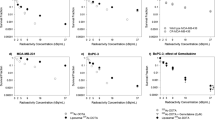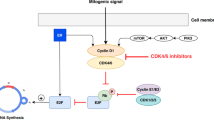Abstract
Two new compounds, 4-[4-[bis-(2-chloroethyl)-amino-]phenyl]-1-hydroxybutane-1,1-bisphosphonic acid (BAD) and aminotris-(methylenephosphonato)diamminoplatinum(ii) (ADP) that both have cytostatic and osteotropic properties, have shown good therapeutic efficacy against an osteosarcoma which metastasizes and kills by lung metastases. We therefore combined each of these drugs with the antimetastatic agent razoxane. Razoxane (20 mg/kg i.p., 5 days/week for 6 weeks) was administered in combination with either BAD (30 mg/kg i.p.) or ADP (37·5 mg/kg i.v.) twice weekly for 3 weeks. Tumour volumes, body weight, survival time and occurrence of metastases were recorded, in addition to the measurement of the metastasis area compared to the total lung area in serial histological lung samples. In both experiments, razoxane effected a significant increase in life span while being ineffective in tumour inhibition. Razoxane in combination with BAD displayed an enhanced anticancer activity which was not significant. ADP had a good antineoplastic activity and a large increase in survival time (144 per cent I LS). Razoxane used in combination with ADP did not influence antitumour efficacy. Median survivals of both ADP-treated groups were significantly longer than the razoxane-treated group. Analysis of the lung metastasis area showed a maximum of 57 per cent for the controls while all treated groups occupied a lesser area. The lowest metastases area was found with the combination treatment BAD + RAZ (18 per cent). This was considered an antimetastatic effect, while ADP treatment effected a time delay only. No change in metastatic pattern was observed in any of the treatment groups. Histological examination showed no effect on the capillaries in the proliferating region of the tumours that could account for the lower occurrence of metastases.
Similar content being viewed by others
References
Adami, S.,Salvagno, G.,Guarrera, G.,Montesanti, F.,Garavelli, S.,Rosini, S., andLocascio, V., 1986, Treatment of Paget's disease of bone with intravenous 4-amino-1-hydroxybutylidene-1,1-bisphosphonate.Calcified Tissue International, 39, 226–229.
Albanese, R., andWatkins, P. A., 1985, The mutagenic activity of razoxane (ICRF 159): an anticancer agent.British Journal of Cancer,52 (5), 725–731.
Attardo-Parrinello, G.,Merlini, G.,Pavesi, F.,Crema, F.,Fiorentini, M. L., andAscari, E., 1987, Effects of a new aminodiphosphonate (aminohydroxybutylidene diphosphonate) in patients with osteolytic lesions from metastases and myelomatosis.Archives of International Medicine,147, 1629–1633.
Boonekamp, P.,Van Der Wee-Pals, L. J. A.,Van Wijk-Van Lennep, M. M. L.,Wil Thesing, C., andBijvoet, O. L. M., 1986, Two modes of action of bisphophosphonates on osteoclastic resorption of mineralized matrix.Bone and Mineral,1, 27–39.
Canfield, R. E., 1987, Rationale for disphosphonate therapy in hypercalcemia of malignancy.American Journal of Medicine,82 (2A), 1–5.
Coleman, R. E., andRubens, R. D., 1987, 3(Amino-1,1-hydroxypropylidene) bisphosphonate (APD) for hypercalcemia of breast cancer.British Journal of Cancer,56, 465–469.
Fischer, V. W.,Wang, G. M., andHobart. N. H., 1986, Mitigation of an anthracycline-induced cardiomyopathy by pretreatment with razoxane: a quantitative morphological assessment.Virchows Archiv,51 (4), 353–361.
Gilbert, J. M., 1986, Trials of adjuvant chemotherapy in colorectal cancer.Drugs Experimental Clinical Research,12 (1-3), 201–210.
Gilbert, J. M.,Hellmann, K.,Evans, M.,Cassell, P. G.,Taylor, R. H.,Stoodley, B.,Ellis, H., andWastell, C., 1986, Randomized trial of oral adjuvant razoxane (ICRF 159) in resectable colorectal cancer: five year follow up.British Journal of Surgery,73 (6), 446–450.
Harinck, H. I. J.,Papapoulos, S. E.,Blanksma, H. J.,Moolenaar, A. J.,Vermeij, P., andBijvoet, O. L. M., 1987, Paget's disease of bone: early and late reponses to three different modes of treatment with aminohydroxypropylidene bisphosphonate (APD). British Medical Journal, 295, 1301–1305.
Hellmann, K., 1984, Razoxane. Clinical Chemotherapy, vol. III: Antineoplastic Chemotherapy, edited by H. P. Kuemmerle (New York: Thième Stratton), pp. 275–282.
Herman, E.,Witiak, D.,Hellmann, K., andWaravdekar, V., 1982, Biological properties of ICRF-159 and related bis(dioxopiperazine) compounds.Advances in Pharmacology and Chemotherapy,19, 294–298.
Kalbfleisch, J. D., andPrentice, R. E., 1980, The Statistical Analysis of Failure Time Data. (New York: Wiley).
Klenner, T.,Münch, H.,Schmähl, D., andKeppler, B., 1988, Efficacy of new cisplatin-linked bisphosphonates in transplantable rat osteosarcoma.Journal of Cancer Research and Clinical Oncology, 114, S162.
Klenner, T.,Blum, H.,Krempien, B., andSchmähl, D., 1988, Protective effect of 3-disodium-hydroxy-propylidene-1,1-bisphosphonate derivatives in prophylactic treatment of osteolytic bone-lesions induced by Walker carcinosarcoma 256 B in the rat.European Society on Medical Oncology, Abstracts of the 13th Congress,C70, 278(P).
Koziol, A. J., andDonna, A. M., 1981, A distribution-free test for tumour growth curve analysis with application to an animal tumour immunotherapy experiment.Biometrics,37, 383–390.
Krempien, B.,Wingen, F.,Eichmann, T.,Müller, M., andSchmähl, D., 1988, Protective effects of a prophylactic treatment with the bisphosphonate 3-amino-lhydroxypropane-1,1-bisphosphonic acid on the development of tumor osteopathies in the rat: experimental studies with the Walker carcinosarcoma 256.Oncology,45, 41–46.
Löwik, C. W. G. M.,Van Der Pluijm, G., andBijvoet, O. L. M., 1987, Migration and phenotypic transformation of osteoclast-precursors into mature osteoclasts: the effect of dimethyl-APD (Me2APD).Calcified Tissue International,41 (Suppl. 2), 49.
Marie, P. J.,Hott, M., andGarba, M., 1985, Inhibition by aminohydroxypropylidene bisphosphonate (AHPrBP) of 1,25(OH)2 vitamin D3-induced stimulated bone turnover in the mouse.Calcified Tissue International,37, 268–275.
Metzger, U. F.,Ghosh, B. C., andKisner, D. L., 1985, Adjuvant treatment of colorectal cancer current status and concepts.Cancer Chemotherapy and Pharmacology,14(1), 1–8.
Meunier, P. J.,Chapuy, M.,Delmas, P.,Charhon, S.,Edouard, C., andArlot, M., 1987, Intravenous disodium etidronate therapy in Paget's disease of bone and hypercalcemia of malignancy.American Journal of Medicine, 82 (2A), 71–78.
Merriman, R. L.,Tanzer, L. R.,Shakelford, K. A.,Bemis, K. G.,Campbell, J. B., andMatsumoto, K., 1988, Inhibition of spontaneous metastasis of Lewis lung carcinoma with a variety of antithrombotic agents does not increase survival.Clinical and Experimental Metastasis,6, (Suppl. 1), p. 98.
Papaloulos, S. E.,Aleman, B. M. P.,Hoekman, K.,Löwik, C. W. G. M., andBijvoet, O. L. M., 1987,In vitro assessment of the potency of bisphosphonates can be predictably confirmed in a patient-observer independent clinical model.Calcified Tissue International,41 (Suppl. 2), p. 60.
Reitsma, H. P.,Bijvoet, O. L. M.,Potokar, M.,Van Der Wee-Pals, L. J. A., andVan Wijk-Van Lennep, M. M. L., 1983, Apposition and resorption of bone during oral treatment with (3-amino-1-hydroxypropylidene)-1,1-bisphosphonate (APD).Calcified Tissue International,35, 357–361.
Sava, G.,Giraldi, T.,Perissin, L.,Zorzet, S., andDecorti, G., 1987, Effects of antimetastatic, antiinvasive and cytotoxic agents on the growth and spread of transplantable leukemias in mice.Clinical and Experimental Metastasis,5 (1), 27–34.
Schenk, R.,Eggli, P.,Fleisch, H., andRosini, S., 1986, Quantitative morphometric evaluation of the inhibitory activity of new aminobisphosphonates on bone resorption in the rat.Calcified Tissue International,38, 342–349.
Scheulen, M. E., 1985, Kardiotoxische Nebenwirkungen von Zytostatika. Die Anthrazylin-Kardiotoxizität.Münchner Medizinische Wochenschrift,127 (37),862–8666.
Scher, H. I., andYagoda, A., 1987, Bone metastasis: Pathogenesis, treatment, and rationale for use of resorption inhibitors.American Journal of Medicine,82 (2A), 6–28.
Shinoda, H.,Adamek, G.,Felix, R.,Fleisch, H.,Schenk, R., andHagan, P., 1983, Structure-Activity Relationships of various Bisphosphonates.Calcified Tissue International,35, 87–99.
Van Holten-Verzantvoort, A. T.,Bijvoet, O. L. M.,Hermans, J.,Harinck, H. I. J.,Elte, J. W. F.,Beex, L. V. A. M.,Cleton, F. J.,Kroon, H. M.,Vermey, P.,Neijt, J. P., andBiljham, G., 1987, Reduced morbidity from skeletal metastases in breast cancer patients during long-term bisphosphonate (APD) treatment.Lancet,10, 983–985.
Wingen, F.,Schmahl, D.,Berger, M. R., andSpring, H., 1984, Intraosseously transplantable osteosarcoma with regularly disseminating pulmonary metastases in rats.Cancer Letters,23, 201–211.
Wingen, F.,Eichmann, T.,Manegold, C., andKrempien, B., 1986, Effects of new bisphosphonic acids on tumor-induced bone destruction in the rat.Journal of Cancer Research and Clinical Oncology,111 (1), 35–46.
Wingen, F.,Sterz, H.,Blum, H.,Möller, H.,Pittermann, W.,Pool, B. L.,Sinn, H. J.Spring, H., andSchmähl, D., 1986, Synthesis, antitumor activity, distribution and toxicity of 4-[4-bis(2-chloroethyl)amino)phenyl]-1-hydroxybutane-1,1-bisphosphonate (BAD), a new lost derivative with increased accumulation in rat osteosarcoma.Journal of Cancer Research and Clinical Oncology,111, 209–219.
Wingen, F., andSchmähl, D., 1987, Pharmakokinetiks of the osteotropic diphosphonate 3-amino-1-hydroxypropane-1,1-diphosphonic acid in mammals.Drug Research,37 (II), 1037–1042.
Wingen, F.,Spring, H.,Schm-hl, D., 1987, Antimetastatic effects of razoxane in a rat osteosarcoma model.Clinical and Experimental Metastasis,5, 9–16.
Author information
Authors and Affiliations
Rights and permissions
About this article
Cite this article
Klenner, T., Wingen, F., Keppler, B. et al. Therapeutic efficacy of two different cytostatic-linked phosphonates in combination with razoxane in the transplantable osteosarcoma of the rat. Clin Exp Metast 8, 345–359 (1990). https://doi.org/10.1007/BF01810680
Received:
Accepted:
Issue Date:
DOI: https://doi.org/10.1007/BF01810680




